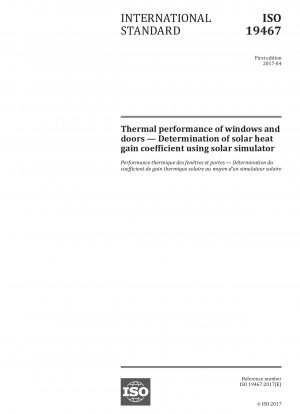ISO 19467:2017
Thermal performance of windows and doors - Determination of solar heat gain coefficient using solar simulator
- Standard No.
- ISO 19467:2017
- Release Date
- 2017
- Published By
- International Organization for Standardization (ISO)
- Latest
- ISO 19467:2017
- Scope
- This document specifies a method to measure the solar heat gain coefficient of complete windows and doors. This document applies to windows and doors a) with various types of glazing (glass or plastic; single or multiple glazing; with or without low emissivity coatings, and with spaces filled with air or other gases), b) with opaque panels, c) with various types of frames (wood, plastic, metallic with and without thermal barrier or any combination of materials), d) with various types of shading devices (blind, screen, film or any attachment with shading effects), e) with various types of active solar fenestration systems [building-integrated PV systems (BIPV) or building-integrated solar thermal collectors (BIST)]. This document does not include the following: a) shading effects of building elements (e.g. eaves, sleeve wall, etc.); b) heat transfer caused by air leakage between indoors and outdoors; c) ventilation of air spaces in double and coupled windows; d) thermal bridge effects at the rebate or joint between the window or door frame and the rest of the building envelope. This document does not apply to the following: a) non-vertical windows; b) curtain walls; c) industrial, commercial and garage doors.
ISO 19467:2017 Referenced Document
- CIE 130-1998 Practical Methods for the Measurement of Reflectance and Transmittance
- CIE 85-1989 Solar Spectral Irradiance (1st Edition) (E)
- EN 14500:2008 Blinds and shutters - Thermal and visual comfort - Test and calculation methods
- EN 14501:2005 Blinds and shutters - Thermal and visual comfort - Performance characteristics and classification
- IEC 60584-1:2013 Thermocouples - Part 1: Ed. 3.0: EMF specifications and tolerances
- IEC 60904-9:2007 Photovoltaic devices - Part 9: Solar simulator performance requirements
- ISO 12567-1:2010 Thermal performance of windows and doors - Determination of thermal transmittance by the hot-box method - Part 1: Complete windows and doors
- ISO 15099:2003 Thermal performance of windows, doors and shading devices - Detailed calculations
- ISO 52022-3 Energy performance of buildings - Thermal, solar and daylight properties of building components and elements - Part 3: Detailed calculation method of the solar and daylight characteristics for solar protection devices combined with glazing*, 2017-06-01 Update
- ISO 7345:1987 Thermal insulation; Physical quantities and definitions
- ISO 8301:1991 Thermal insulation; determination of steady-state thermal resistance and related properties; heat flow meter apparatus
- ISO 8990:1994 Thermal insulation - Determination of steady-state thermal transmission properties - Calibrated and guarded hot box
- ISO 9050:2003 Glass in building - Determination of light transmittance, solar direct transmittance, total solar energy transmittance, ultraviolet transmittance and related glazing factors
- ISO 9288:1989 Thermal insulation; heat transfer by radiation; physical quantities and definitions
- ISO 9845-1:1992 Solar energy; reference solar spectral irradiance at the ground at different receiving conditions; part 1: direct normal and hemispherical solar irradiance for air mass 1,5
- ISO/IEC GUIDE 98-3:2008 Uncertainty of measurement — Part 3: Guide to the expression of uncertainty in measurement (GUM:1995)
ISO 19467:2017 history
- 2017 ISO 19467:2017 Thermal performance of windows and doors - Determination of solar heat gain coefficient using solar simulator
